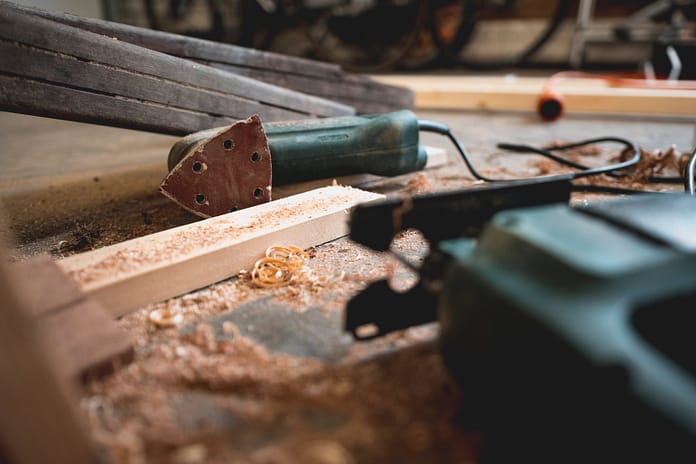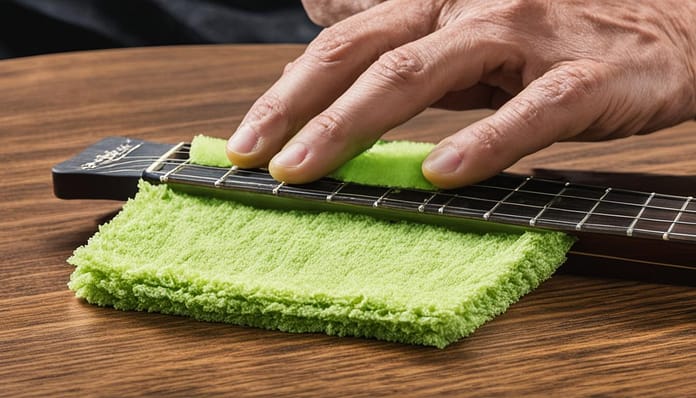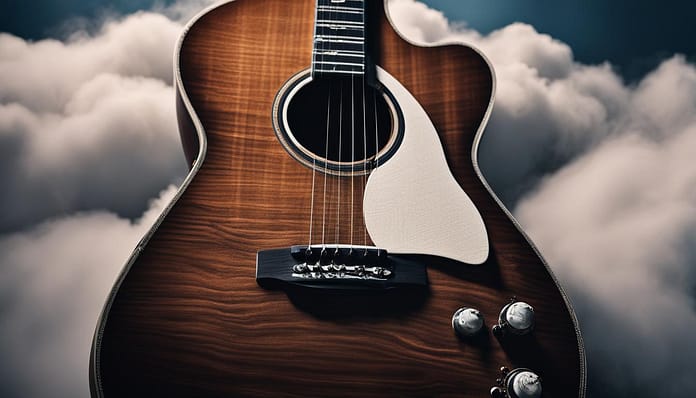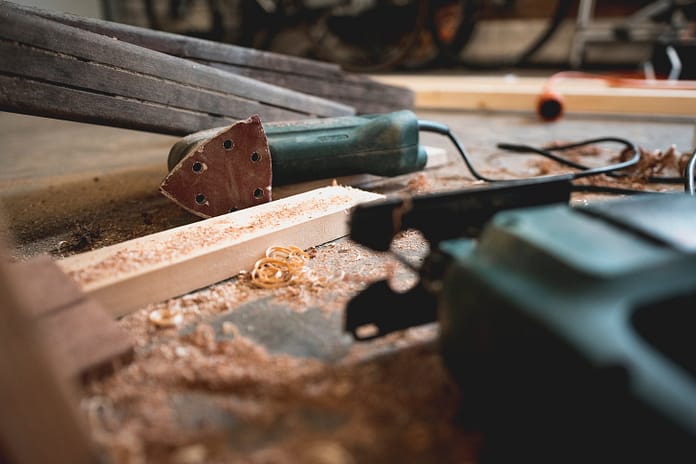This post may contain affiliate links. As an Amazon associate, Google associate as well as associate for other programs, Guitar & Music Institute may earn commissions from qualifying purchases.

Investing in a guitar is an investment in your musical journey. Regular maintenance and proper handling are crucial for preserving your guitar’s performance, sound quality, and lifespan. This comprehensive guide will cover essential aspects of guitar maintenance, including cleaning, string changes, humidification, and storage. By following these best practices, you can protect your instrument, enhance playability, and ensure a consistently exceptional playing experience.
Key Takeaways:
- Regular maintenance and proper handling are essential for preserving your guitar’s performance and sound quality.
- Cleaning and polishing your guitar regularly improves its appearance and enhances its performance.
- Regular string changes are crucial for maintaining optimal tone and playability.
- Proper fretboard and fret maintenance enhances playability and prevents wear and tear.
- Protecting your guitar from environmental factors, such as temperature and humidity, is vital for its longevity.
The Importance of Cleaning and Polishing Your Guitar
Regular cleaning and polishing are essential for maintaining the performance and appearance of your guitar. Accumulated dust, dirt, and oils can degrade the finish and affect the tonal qualities of your instrument. By following proper cleaning techniques and using the right products, you can protect your guitar’s condition and ensure it continues to shine both on and off stage.
Here are some best practices for guitar cleaning and polishing:
Step 1: Gather the necessary cleaning supplies
Before you begin, make sure you have the following essentials:
- Guitar cleaning solution
- Microfiber or lint-free cloth
- Guitar polish or wax (optional)
- Detailed cleaning brush or toothbrush
Step 2: Remove dirt and dust
Start by gently wiping the guitar body, neck, and headstock with a microfiber cloth to remove any surface dust or dirt. Pay attention to hard-to-reach areas, such as around the bridge and pickups. If there are stubborn spots, use a detailed cleaning brush or toothbrush to gently loosen the grime.

Step 3: Clean the fretboard
The fretboard requires special care. If it’s made of maple or other sealed woods, you can simply wipe it with a slightly damp cloth. For unfinished or rosewood fretboards, you can use a small amount of specialized fretboard cleaner to remove grime and restore its natural shine. Be sure to follow the manufacturer’s instructions when using any cleaning products.
Step 4: Polish the guitar finish (optional)
If your guitar has a glossy finish, you may choose to apply a guitar polish or wax to enhance its shine. Apply a small amount of polish to a clean cloth and gently rub it onto the guitar body in circular motions. Be careful around the hardware and avoid getting polish on the fretboard or any other non-glossy surfaces. Allow the polish to dry, then buff it off with a clean cloth for a brilliant shine.
Step 5: Maintain regular cleaning habits
To keep your guitar looking and sounding its best, it’s important to establish a regular cleaning routine. Wipe down the guitar after each playing session to remove sweat and oils. Additionally, consider investing in a guitar maintenance kit that includes cleaning solutions, polishes, and specialized tools for thorough and effective maintenance.
| Benefits of cleaning and polishing your guitar: | Drawbacks of neglecting guitar maintenance: |
|---|---|
| Preserves the guitar’s finish and appearance | Buildup of dirt and grime affects the sound quality |
| Maintains the guitar’s playability and fretboard condition | Increase in string corrosion and breakages |
| Protects the hardware and extends its lifespan | Reduces the guitar’s resale value |
Regularly cleaning and polishing your guitar not only keeps it looking great but also ensures optimal performance and longevity. By following these guitar maintenance essentials and best practices, you can enjoy playing your instrument at its full potential for years to come.
The Significance of Regular String Changes
Guitar strings lose their brightness and playability over time. Regular string changes are essential for maintaining optimal tone and preventing string breakages. By staying on top of string maintenance, you can ensure that your guitar always sounds its best. Here are some important considerations when it comes to guitar maintenance and upkeep for beginners:
Frequency of String Changes
How often you should change your guitar strings depends on various factors, including how frequently you play, your playing style, and the type of strings you use. As a general guideline, it’s recommended to change your strings every 1-3 months. However, if you notice a significant decline in tone or if your strings become rusty or worn, it’s time for a change. Regular string changes not only improve the sound quality but also prolong the life of your instrument.
Choosing the Right String Material
The type of guitar strings you choose can greatly impact your playing experience. There are different materials available, such as nickel-plated steel, stainless steel, and phosphor bronze. Each material offers unique characteristics in terms of brightness, warmth, and longevity. Experiment with different string types to find the sound and feel that suits your playing style and preferences.
Proper String Winding Techniques
Correctly winding your guitar strings can significantly improve tuning stability and minimize string slippage. When changing your strings, make sure to properly wrap them around the tuning pegs. Avoid leaving excess string slack and ensure that each string is securely wound. This will help maintain accurate tuning and prevent unnecessary string breakages during intense playing sessions.
Regular string changes and proper maintenance are fundamental to keeping your guitar in peak condition. By following these guitar maintenance tips and tricks, you can ensure that your instrument always delivers the best sound and performance.
| Benefits of Regular String Changes | Tips for Choosing the Right Strings | Proper String Winding Techniques |
|---|---|---|
| 1. Maintains optimal tone | 1. Consider the material | 1. Avoid excess string slack |
| 2. Prevents string breakages | 2. Experiment with different types | 2. Securely wrap the strings |
| 3. Prolongs the life of your instrument | 3. Find the sound and feel you prefer | 3. Improve tuning stability |
Maintaining Your Guitar’s Fretboard and Frets
The fretboard of your guitar is a critical component that requires special care to ensure optimal performance and longevity. Cleaning and conditioning the fretboard not only prevent wear and tear on the frets but also enhance the overall playability of your instrument.
Cleaning Your Fretboard
To clean your guitar’s fretboard, follow these steps:
- Remove the strings: Loosen and remove the strings to access the fretboard properly.
- Use a soft cloth: Gently wipe away any dirt, grime, or oils from the fretboard using a soft cloth.
- Apply a fretboard cleaner: Use a specialized fretboard cleaner or a mixture of lemon oil and water to remove stubborn residue. Apply a small amount to the cloth and rub it onto the fretboard.
- Wipe off excess cleaner: After cleaning, wipe off any excess cleaner from the fretboard.
Conditioning Your Fretboard
Conditioning the fretboard helps prevent drying and cracking, keeping it in optimal condition. Follow these steps to condition your guitar’s fretboard:
- Choose a suitable conditioner: Select a high-quality fretboard conditioner, such as lemon oil or specialized guitar fretboard oil, to condition your fretboard.
- Apply the conditioner: Apply a small amount of conditioner to a clean cloth, then rub it into the fretboard, ensuring even coverage.
- Let it sit: Allow the conditioner to penetrate the wood for a few minutes.
- Wipe off excess conditioner: After the recommended time, wipe off any excess conditioner from the fretboard.
Assessing Fret Wear
Regularly assessing the condition of your guitar’s frets is essential to identify any signs of wear or damage. Here are some indicators of fret wear:
- Fret grooves: Look for deep grooves or indentations in the frets caused by string contact.
- Fret buzz: If you experience excessive buzzing or muting of certain notes, it may indicate worn-out or uneven frets.
- Intonation issues: Poor intonation, where the guitar is not properly in tune across the fretboard, can be a result of worn frets.
If you notice any significant fret wear or experience persistent issues, it is recommended to seek professional fret maintenance to ensure optimal playability and performance.
| Signs of Fret Wear | Actions |
|---|---|
| Fret grooves or indentations | Consider fret leveling and dressing |
| Excessive fret buzz | Consult a professional for fret crowning and leveling |
| Poor intonation | Check fret height and consider necessary adjustments |
Regular fret maintenance ensures the longevity and optimal performance of your guitar, allowing you to enjoy playing your instrument for years to come.

Protecting Your Guitar from Environmental Factors
Environmental factors such as temperature and humidity can have a significant impact on the structure of your guitar, potentially causing damage and affecting its overall performance. To ensure the longevity of your instrument, it is crucial to implement proper storage techniques and humidity control measures.
Investing in a Quality Case
One of the most effective ways to protect your guitar from environmental factors is by investing in a high-quality case. A sturdy, well-padded case provides insulation against temperature changes and shields your guitar from dust, dirt, and accidental impacts. Look for a case that offers a snug fit to avoid any movement or potential damage during transport.
Monitoring Humidity Levels
Guitars are particularly susceptible to changes in humidity. Excess moisture can cause the wood to swell and potentially warp, while low humidity levels can lead to drying out and cracking. To maintain a stable humidity environment, consider using a hygrometer to monitor the humidity levels in the room where you store your guitar.
Avoiding Exposure to Extreme Temperatures
Extreme temperatures can also harm your guitar. Excessive heat can cause the glue to soften and weaken, leading to structural issues, while extreme cold can affect the playability and tuning stability of your instrument. Avoid storing your guitar in areas prone to temperature fluctuations, such as attics, garages, or cars.
To maintain the optimal environment for your guitar, consider using a humidifier or dehumidifier, depending on the climate you live in. Additionally, keep your guitar away from direct sunlight, which can cause fading or discoloration of the finish.

The Role of High-Quality Accessories in Guitar Maintenance
When it comes to maintaining your guitar’s performance and extending its lifespan, investing in high-quality accessories is paramount. Guitar capos and strap locks are two essential accessories that can significantly enhance your playing experience while ensuring the safety of your instrument. Let’s delve into how these accessories play a crucial role in guitar maintenance.
Guitar Capos: Unlocking Musical Possibilities
A guitar capo is a versatile accessory that allows you to change the pitch of your guitar’s open strings. By clamping down on a particular fret, the capo effectively raises the pitch of the guitar, enabling you to play in different keys without changing your fingerings. This not only expands your creative potential but also helps you achieve a desired sound when playing along with recordings or other musicians.
When choosing a guitar capo, it’s important to opt for a high-quality one that provides even pressure across the strings and fretboard. A well-designed capo ensures accurate intonation and maintains proper tuning stability, allowing you to play in tune regardless of the key you’re in. Additionally, a quality capo minimizes unwanted string buzzing and ensures a secure grip without damaging your guitar’s finish.
Guitar Strap Locks: Protecting Your Investment
Playing the guitar while standing requires a reliable strap to support the weight of the instrument. However, conventional strap attachments can sometimes fail, leading to potential damage to your guitar or even accidents during performances. This is where guitar strap locks come into play.
Guitar strap locks provide a secure connection between your guitar and strap, ensuring that your instrument remains safely in place while you play. These locks use a locking mechanism that prevents the strap from accidentally detaching from the guitar’s strap buttons. By using strap locks, you can have peace of mind knowing that your guitar is protected from unexpected drops or falls.
When selecting guitar strap locks, prioritize durability and ease of use. Look for options made from robust materials and designed to withstand the rigors of live performances. Easy installation and adjustment mechanisms are also crucial, allowing you to quickly attach and remove the strap without hassle.
In summary, high-quality accessories such as guitar capos and strap locks are indispensable for maintaining both the performance and safety of your instrument. By investing in reliable accessories, you can unlock new musical possibilities with a capo and protect your investment with secure strap locks. Enhance your playing experience, ensure your guitar’s longevity, and take your musical journey to new heights with these essential guitar accessories.
| Guitar Capos | Guitar Strap Locks |
|---|---|
| Allows you to play in different keys without changing fingerings | Ensures your guitar remains safely in place while playing |
| Provides accurate intonation and tuning stability | Prevents accidental detaching of the strap |
| Minimizes string buzzing and protects the guitar’s finish | Keeps your instrument safe from drops or falls |
| Offers a secure grip on the fretboard | Durable and easy to install |
Long-Term Guitar Maintenance and Professional Servicing
While regular maintenance is crucial for keeping your guitar in top shape, long-term care is equally important. In this section, we will explore the annual tasks that will help preserve your guitar’s performance, as well as highlight the significance of professional setups and servicing.
Annual Maintenance Tasks
Performing annual maintenance tasks on your guitar ensures that it remains in optimal condition. Here are some essential tasks to consider:
- Clean and polish the guitar body to maintain its appearance and protect the finish.
- Inspect the hardware, including tuning machines, bridge, and nuts, for any signs of wear or damage.
- Check the electronics and wiring for loose connections or any issues with the pickups or controls.
- Assess the overall structural integrity of the guitar, paying attention to any cracks or damage to the body or neck.
Truss Rod Adjustments
The truss rod is a crucial component of your guitar’s neck that helps maintain proper neck curvature and adjust for changes in humidity and string tension. Over time, the neck may require adjustments to ensure optimal playability. It’s essential to consult professional technicians or follow manufacturer guidelines for making truss rod adjustments to prevent damage to your instrument.
Fret Maintenance
Regular fret maintenance ensures smooth playability and prevents fret wear. It may involve cleaning the frets, polishing them, and addressing any uneven frets or sharp edges. This maintenance can be done with DIY techniques, but for more complex issues, it’s advisable to seek professional assistance to avoid unintentional damage to your guitar.
Hardware Upkeep
The hardware components of your guitar, such as the bridge, tuners, and nuts, require regular upkeep to ensure optimal performance. This may include lubricating moving parts, addressing any loose screws or parts, and replacing worn-out components. Proper hardware maintenance contributes to tuning stability and overall playability.
Professional Setups and Servicing
Professional setups and servicing play a vital role in maintaining the long-term health of your guitar. Trained technicians have the expertise to fine-tune your instrument for optimal playability, adjust action and intonation, and address any specific concerns you may have. They can diagnose and resolve issues that might be challenging for the average guitarist to identify or rectify.
Seeking professional servicing allows you to benefit from the knowledge and experience of skilled technicians, ensuring that your guitar receives the attention it deserves. Whether it’s an annual check-up or addressing specific concerns, professional setups and servicing can greatly enhance your playing experience.
Remember, investing in proper long-term maintenance and periodic professional servicing will help extend the lifespan of your guitar and preserve its optimal playability for years to come.
| Maintenance Task | Frequency |
|---|---|
| Clean and polish the guitar body | Every 1-2 months |
| Inspect hardware | Every 3-6 months |
| Check electronics and wiring | Annually or as needed |
| Assess structural integrity | Annually or as needed |
Conclusion
Proper guitar maintenance and care are essential for preserving your instrument’s performance, appearance, and longevity. By following these guitar maintenance tips, you can ensure that your guitar remains in optimal condition for peak performance.
Start by cleaning and polishing your guitar regularly to remove dust, dirt, and oils that can impact its finish and sound quality. Remember to change your guitar strings regularly to maintain optimal tone and prevent string breakages.
Don’t forget to pay attention to your guitar’s fretboard and frets. Regular cleaning and conditioning will prevent wear and tear and enhance playability. Protect your guitar from environmental factors such as temperature and humidity by investing in a quality case and monitoring humidity levels.
Invest in high-quality accessories like guitar capos and strap locks, which can improve your playing experience and contribute to the longevity of your instrument. Lastly, consider seeking professional servicing and setups annually to ensure that your guitar is in top shape.
FAQ
How often should I clean and polish my guitar?
It is recommended to clean and polish your guitar every 1-2 months, or whenever it appears dirty or dull. Regular cleaning and polishing help maintain the instrument’s appearance and protect its overall condition.
What should I use to clean my guitar?
To clean your guitar, use a soft, lint-free cloth or microfiber cloth. Avoid using harsh chemicals or household cleaners as they can damage the finish. Instead, use specialized guitar cleaning products that are safe for your instrument.
How often should I change my guitar strings?
The frequency of string changes depends on how often you play and the type of strings you use. As a general rule, it is recommended to change your guitar strings every 3-4 months or sooner if they start to sound dull or show signs of wear and tear.
What type of string material should I choose?
The choice of string material depends on your personal preference and playing style. Common options include nickel-plated steel, stainless steel, and coated strings. Experiment with different types to find the ones that best suit your sound and feel preferences.
How do I properly wind my guitar strings?
When installing new strings, make sure to wind them evenly and securely around the tuning pegs. This will improve tuning stability and minimize string slippage. Use a string winder to speed up the process and make sure the strings are properly seated in the nut and bridge.
How do I clean and condition my fretboard?
To clean your fretboard, use a soft cloth dampened with a small amount of lemon oil or specialized fretboard cleaner. Gently wipe off any dirt or grime, taking care not to get the wood too wet. Conditioning the fretboard with lemon oil or specialized fretboard conditioner helps prevent drying and cracking.
When should I seek professional fret maintenance?
If you notice excessive fret wear, buzzing or dead spots on the fretboard, or difficulties with intonation, it may be time to seek professional fret maintenance. A qualified guitar technician can assess the condition of your frets and make any necessary adjustments or replacements.
How should I store my guitar to protect it from environmental factors?
It is important to store your guitar in a quality case or gig bag to protect it from temperature and humidity fluctuations. Avoid exposing your guitar to extreme temperatures or direct sunlight. Monitoring the humidity levels in your storage area and using a guitar humidifier or dehumidifier when necessary can also help safeguard your instrument.
What accessories should I invest in for my guitar?
High-quality accessories like guitar capos and strap locks can enhance your playing experience and contribute to the longevity of your instrument. A capo allows you to easily change the key of a song, while strap locks help secure your strap and prevent accidental drops. Invest in reliable accessories to ensure optimal performance and safety.
What is involved in long-term guitar maintenance?
Long-term guitar maintenance includes annual tasks such as truss rod adjustments, fret maintenance, hardware upkeep, and regular cleaning and conditioning. It is also important to schedule professional setups and servicing to address any specific issues and ensure your guitar is performing at its best.
Check out all our latest guitar downloads and guitar books at gmiguitarshop.com
Source Links
- https://gimenezguitars.com/2020/06/02/simple-and-effective-guitar-maintenance-tips/
- https://kysermusical.com/blogs/news/guitar-maintenance-and-care
- https://www.thelegalimmigrants.com/guitars/electric-guitar-maintenance/
This post may contain affiliate links. As an Amazon associate, Google associate as well as associate for other programs, Guitar & Music Institute may earn commissions from qualifying purchases.



















